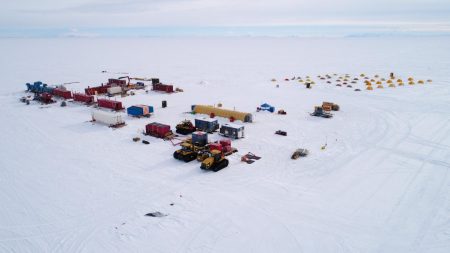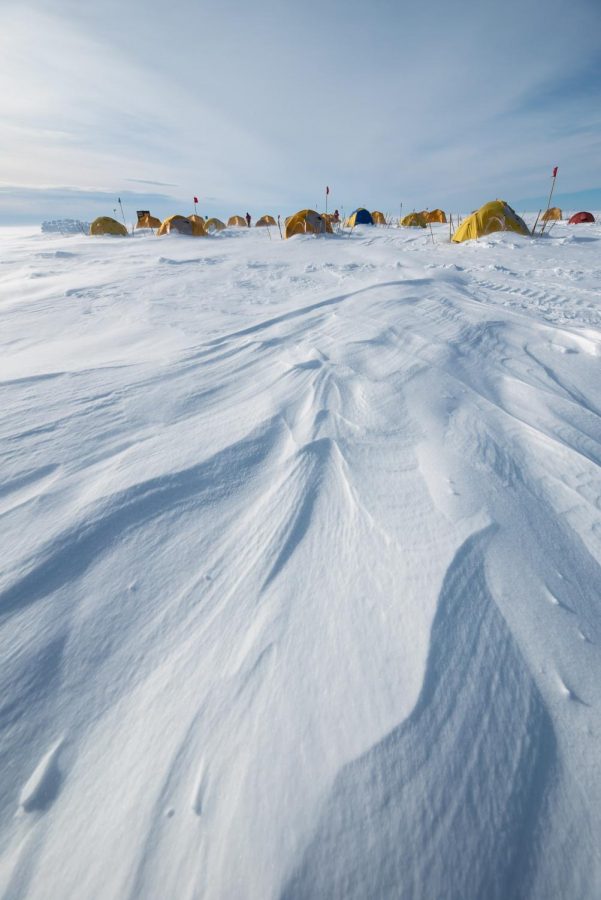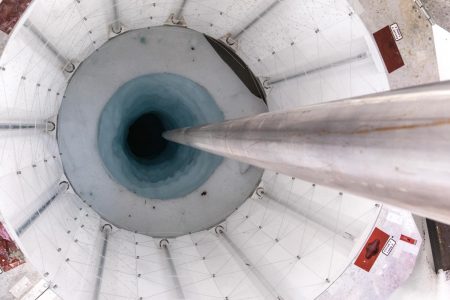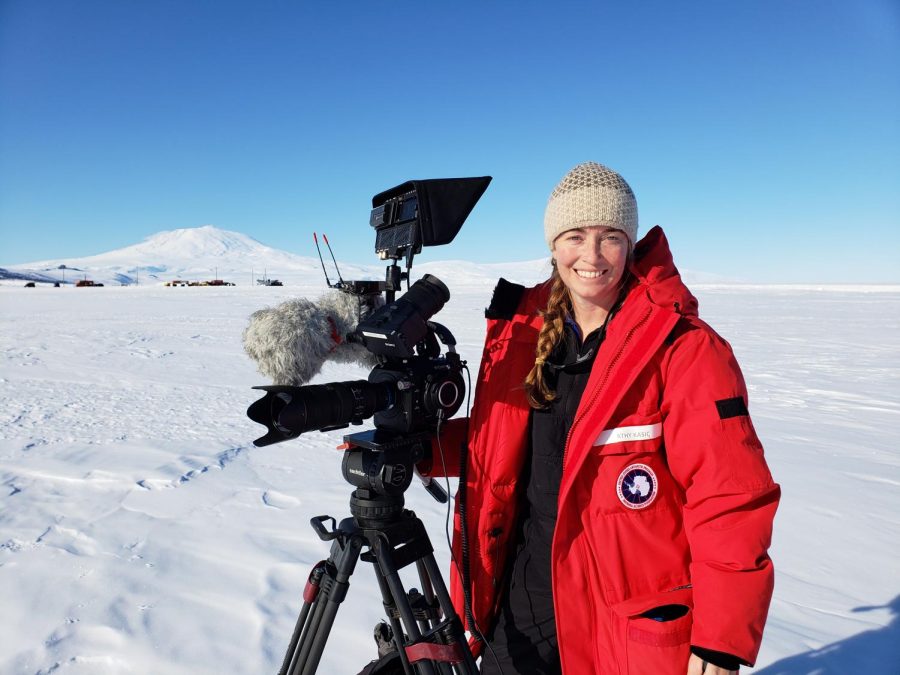Q&A: Sac State film professor Kathy Kasic returns from Antarctic expedition
Kasic spent 6 weeks filming a documentary on subglacial lakes in Antarctica
Photo Courtesy of Billy Collins
Kathy Kasic, a Sac State film professor, at McMurdo Station in Antarctica in Dec. 23. Kasic has returned from her expedition trip where she documented SALSA’s findings.
For six weeks, assistant film professor Kathy Kasic slept in a tent on top of an ice sheet in Antarctica, dealing with frosty temperatures and bitter wind as she filmed.
Kasic traveled with a team of roughly 50 people on an expedition to record evidence of life 1,070 feet below Lake Mercer, a subglacial lake beneath the Whillans Ice Plain. It is the deepest lake to have ever been explored without water contamination.
She left for the expedition on Dec. 2, 2018, but Kasic started planning for her trip four years ago when she approached John Prusci, the chief scientist of the Subglacial Antarctic Lakes Scientific Access.
Together, Kasic and Prusci applied for a grant to allow them to go on an expedition to Antarctica. The grant was approved, and SALSA sent a 43 person team to drill boreholes through Antarctic ice sheets and research the microorganisms preserved in the lake’s water.
Kasic was one of 11 principal investigators on the expedition. Her position on the project revolved around education and outreach while also being the documentary director and cinematographer.
The State Hornet spoke with Kasic about her experience in Antarctica.
Question: Can you tell me about yourself?
Answer: Originally I was born in England but that was a really long time ago, I moved to Canada when I was three. I then moved from Canada to Texas when I was seven. I went to school in the University of Texas in Austin for my undergrad and then again for the master’s program in biology. I started as an art major and then became a biology major after two years. I went to a professor and I told him I wanted to do field work because at the time I wanted to be a field biologist. At the time I was going to Ecuador and he had told me, ‘why don’t you take this microphone?’ and study frogs. I took the microphone and started recording frogs all over the Amazon. It’s such a whacky thing to do but I got to meet so many amazing people and cultures. It’s kind of my background in science.
I went up to Montana and I went to Montana State University and got my MFA (Masters of Fine Arts) in science and natural history filmmaking. It really seemed to fit me well and after that, I started working for BBC. I started to do wildlife programming and I started with a series called “Yellowstone: Battle for Life” and I worked on that for three years and got an incredible education from it. I started shooting for Discovery Channel and PBS.
Q: What did you expect going into this trip?
A: I didn’t know exactly what to expect because I had never been to Antarctica before but I had heard about it and had seen pictures. I knew I was going to be sleeping in a tent on the ice, I didn’t know how I felt about that because I spent a lot of time camping in tents but never on the ice before, 375 miles from the (South) Pole. You’re in a place, where you know, it takes several hours for an aircraft to get you if you need help. If they can’t land, they won’t come get you. So, you’re not entirely sure, if something goes bad, if you’ll be able to leave. So, I didn’t know how to feel about that. When I got there, I felt like, I would deal with it as you do with most things in life. You just do it and it all works out. I didn’t know what the food would be like but the food was a lot better than I thought it would be. I didn’t see a green salad for many, many weeks but you know, I’ve been eating a lot of salads since I got home. But otherwise, they did amazing cooking for 50 people in a camp, completely isolated from everything else.
We originally flew into a place called McMurdo Station and that is a place that houses 800 to 900 people in the busiest times, but everyone leaves when the summer ends. We stayed in dorm rooms and the first room I stayed in had four beds. I hadn’t been exposed to dorm life in a really long time. I know students can relate to that. It was an interesting experience, you know, after having my own place for most of my adult life. It makes you appreciate your own place.

The Lake Mercer camp set up for the SALSA team during their expedition trip in Antarctica. The team was on the ice sheets for six weeks with Sac State professor Kathy Kasic documenting the findings.
story continues below
Q: Can you tell us a little bit about your findings?
A: There were a lot of different findings. In 2007, satellite data said to these researchers that there are lakes under there. It had flat spots that looked like there could be lakes underneath the ice sheet. So that was really interesting. There are lakes and river systems all underneath Antarctica.
We heat water to melt the ice, done in a very clean access way so you’re not mixing lake water with the top water. It was very well thought out. We got out to the lake and it was 1,070 meters under the ice sheet and the lake itself is 15 meters deep, so it’s roughly 1,100 meters to the lake bottom from the surface. Since the ice sheet moves, the hole that we made was constantly moving and you put an instrument down and you come back three days later to bring it back up and the hole has actually moved over so you get a whole new set of samples, it was really amazing.
We collected like 60 liters of lake water, five meters of sediments and all that is going to tell us more about temperature, salinity, and samples for DNA sequencing. So we’ll be able to know what kind of organisms have been down there. We also found an ancient tardigrade, not something living. We still have to figure out if we had live animals down there so we’re going to DNA sequence that to know, so that’s going to take a couple months. Also found diatoms in the sediment and as far as we can tell, we don’t think that lake has seen the light of day for 100,000 years.
A Glimpse of Mercer Subglacial Lake – SALSA Science Team from SALSA Antarctica on Vimeo.
Story continues below
Q: What kind of equipment did you take with you? How did it do in such extreme weather?
A: I am making a documentary about the whole experience and expedition and that will be an hour-long documentary for PBS. So to make that film and the two that [SALSA is] making we had to bring several different cameras. We had a DSLR and larger Sony camera. I brought several different microphones. I’m really into sound, you know, since it’s my background. I took a stereo mic and a VR mic that can record sound all around and took some 360 video. We also brought two drones and one didn’t survive, it just died on its own but we got a lot of good footage on the other one. I also had the deep water housing with the light, I took a GoPro.
A lot of the time I had a hard time with my eyepiece fogging up, you know just to focus, so that was one issue I ran into. I think we were pretty lucky for the most part. When it was windy it was pretty challenging because it was cold to be filming with your hands. Surprisingly it wasn’t as cold where we were, it is definitely colder in other areas but when it was windy, it would really get cold. Nothing worse than a Montana winter.

Tents the SALSA team slept in on top of the ice sheet 300,075 miles from the Pole in Antarctica. The team includes Sac State professor Kathy Kasic who documented SALSA’s findings.
story continues below
Q: What kind of filming did you do? For how many hours in a day?
A: Once the borehole was open, everyone had to go and do work, everyone had to put their instruments down and we would film. Scientists would work on shifts and would be tired too because they were working all the time, but we just never slept. There were many, many days where I have this footage of myself just exhausted, I don’t even look like myself anymore. The lack of sleep kind of changes your persona, so there were days where I would [get] about an hour and a half of sleep or maybe two hours. That for me was the biggest challenge, trying to figure out how not to be delirious. However, that didn’t last very long, maybe 10 days or so.
Other days it would depend. Some days we would go all day into the night. The problem was that we were working in such a way where we didn’t want to fake anything. We wanted to capture life unfolding the way life unfolds, but the problem when you’re filming like that is you actually have to watch and wait. It means having a lot of anticipation for what might happen, and preparing for that, and being there for it and being present all the time. Being present can be a very wonderful thing but it can also be very exhausting. On other days when we weren’t working on the borehole, we would pick and choose or put down our cameras.

The SALSA team drilled holes on the ice sheets with hot water to reach the lakes underneath. Shown are the UV Collar, Borehole, and hot water drill.
Your donation will support the student journalists of Sacramento State University. Your contribution will allow us to purchase equipment and cover our annual website hosting costs.


























































































































